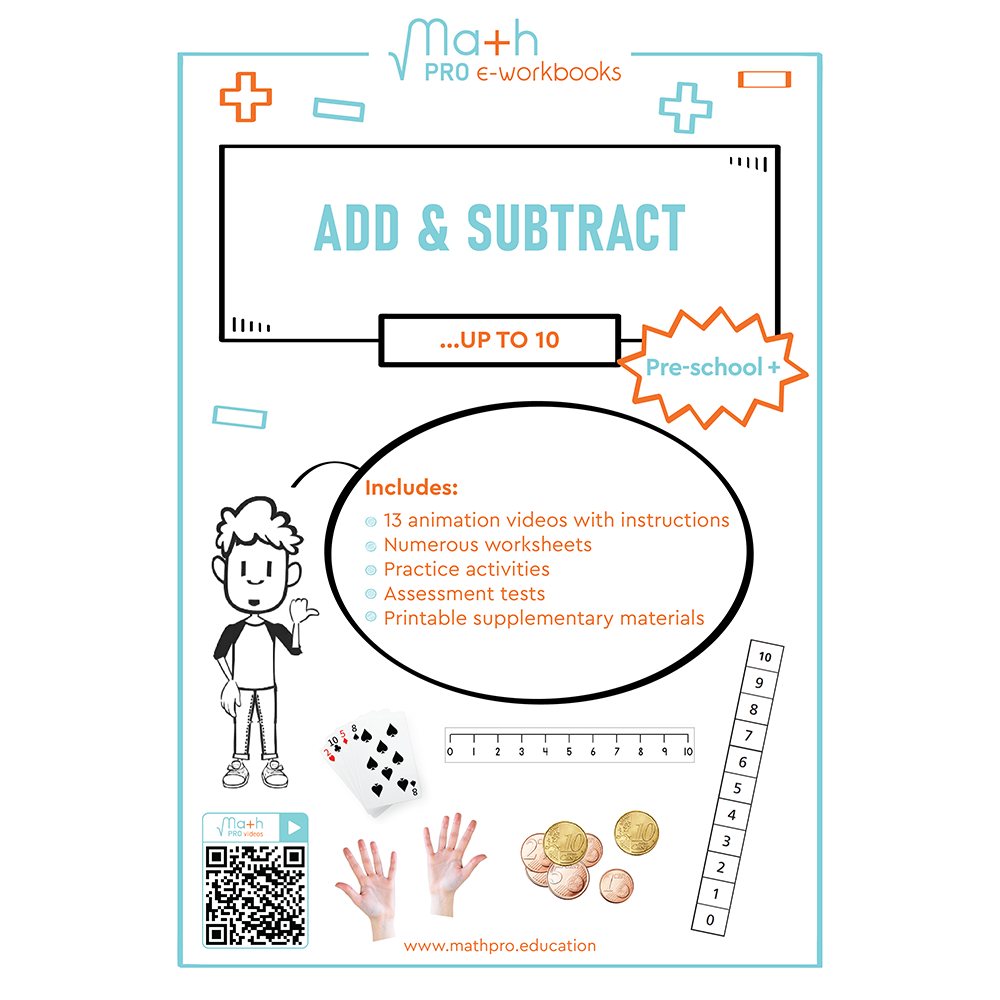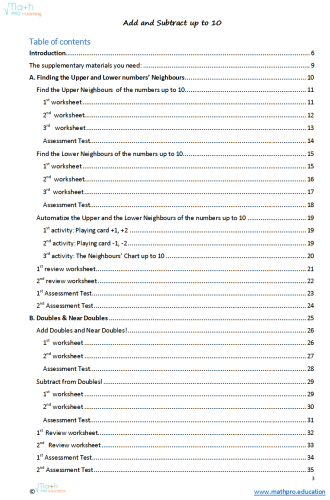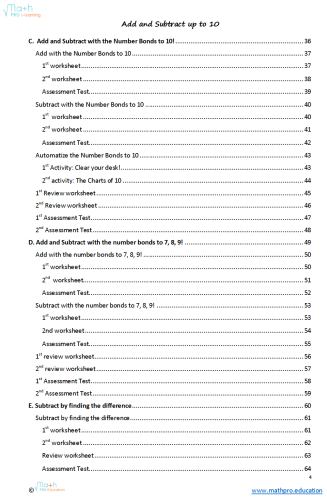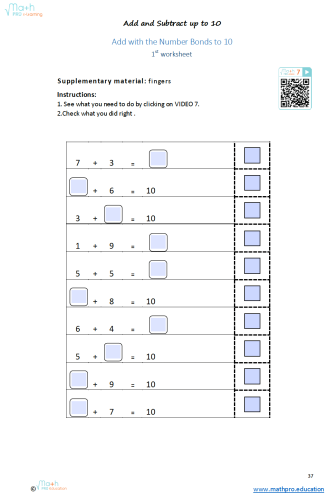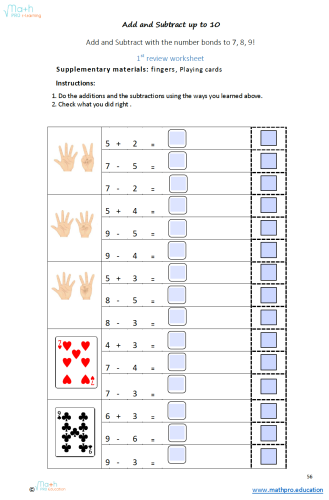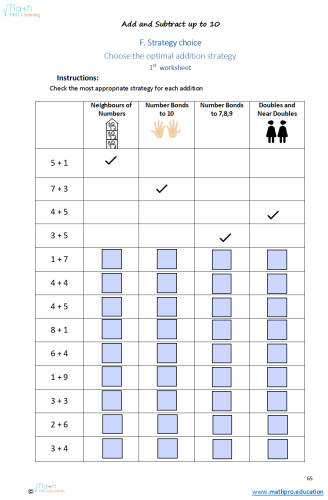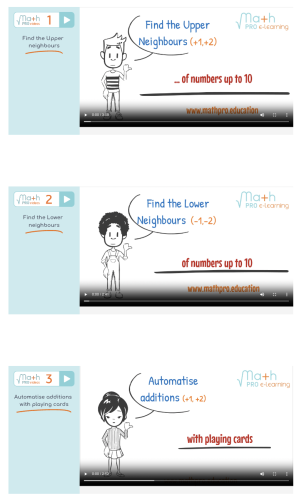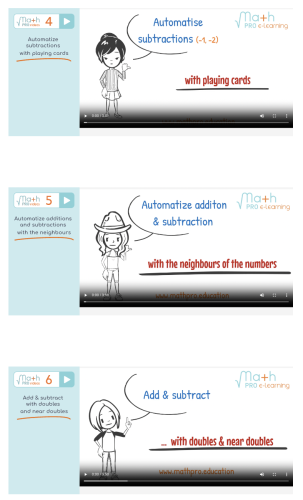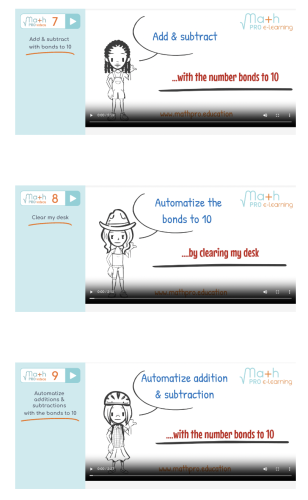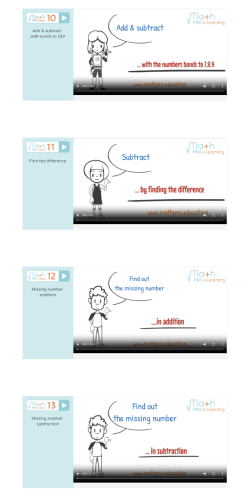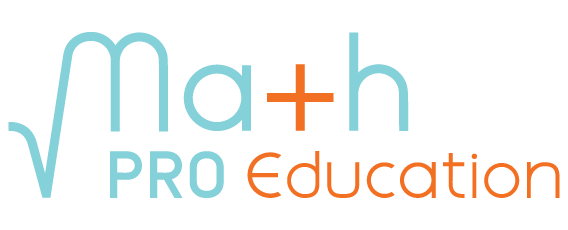Addition & Subtraction up to 10
INCLUDES
PDF (96 pages) & 13 ANIMATION VIDEOS.
MATHEMATICAL SKILL TO BE CULTIVATED
Mental additions and subtractions of all categories up to 10.
EXPECTED OUTCOMES
The student should perform mental additions and subtractions up to 10 fluently.
WHO CONCERNS
From preschool children and above.
Scientific Executive Officer: Dr. Giannis Karagiannakis
Editorial - Digital Editing: Ioanna Stroumpouli, ΒEd, MEd Special Educator
Cover-Digital forms: Ro Chalatsoglou
ISBN: 978-618-85498-6-9
© Copyright MathPro Education Athens, 2023
Year of 1st edition: 2023
Description
Teaching objective: The aim of this e-book is to train students of mixed ability (low, typical, high) to perform fluently additions and subtractions up to 10 mentally.
Content: This is a student's book containing strategies that are hierarchically structured in terms of pre-requisite mathematical skills as well as level of difficulty.
Supplementary materials:Each strategy makes use of specific supplementary materials (e.g. number charts) found in the appendix, as well as using everyday authentic materials (e.g. coins, rulers, playing cards). The visual and kinesthetic activities through the use of the tangible materials as well as the embodied activities (e.g. use of fingers), contained in this book, aim at understanding the relevant mathematical concepts as well as reducing the required cognitive load. As a result, students are better able to maintain in their memory the steps of the mathematical procedures that each strategy contains.
Αnimation videos:The book is accompanied by videos in which the differentiated strategies are presented in a detailed and entertaining way through animations, making use of the corresponding supplementary materials. Thus, the student can follow and understand each strategy without having to read instructions or have the supplementary materials used.
Structure: Each strategy is a separate module which includes: a) a short introduction (description, the supplementary materials to be used, the accompanying animation videos), b) solved characteristic examples, c) numerous worksheets of increasing difficulty, d) automatization activities, e) revision/evaluation activities. After the modules, there are specially designed activities which aim to train students to choose the optimal (easiest/ fastest /economical) addition or subtraction strategy depending on the size of the numbers used each time in order to stimulate their metacognitive skills. Finally, review assessment sheets are included which contain addition and subtraction activities that can be performed using one or more of the set of strategies presented in this book. The worksheets can be completed in digital or paper format.
Rationale:Learning to perform mental additions and subtractions up to 10 as well as the automatic retrieval of the corresponding facts is considered a very important skill, as it is the basis (or prerequisite) for performing mental and written calculations with larger numbers. Additions and subtractions up to 10 are initially performed by forward counting in addition (e.g. 5+4 = 6, 7, 8, 9) and by backward counting in subtraction (e.g. 10-8 = 10, 9, 8, 7, 6, 5, 4, 3, 2) using the fingers at the same time. However, prolonged use of this method is time consuming and very tiring for the brain especially for larger numbers. This book presents more advanced or superior strategies which contain less cognitive load so that they can be performed more quickly and, with training, can be both automatized and applied to operations with larger numbers.
Audience :The different teaching approaches mentioned above are expected to meet the needs of students of mixed abilities or differently students who have different mathematical cognitive profiles enabling each student to choose the way that best suits them by compensating for their potential difficulties which may be due to either deficient learning or innate difficulties (dyslexia, dyscalculia, ADHD, autistic spectrum, borderline intelligence, etc.). On the other hand, it is also addressed to students with standard or high mathematical skills, who are looking for more advanced strategies to perform mental calculations with accuracy and speed.
Age group:This book is primarily aimed at pupils completing kindergarten and mainly first grade, as the strategies contained in the book relate to the relevant topics in the school curriculum. However, it can also be used by pupils in older classes who have difficulty in performing mental operations with numbers up to 10 (e.g. they insist on counting strategies using their fingers) or have not automated them.
Acknowledgment: Several of the strategies and ideas presented in this book are derived from the RekenTrapperS teaching method developed by Anny Cooreman at Eureka Leuven School in Belgium and have been successfully implemented since 2000 as the exclusive teaching method at this school and have been adopted by other educational institutions. Dr. Giannis Karagiannakis has been collaborated as a research associate at the Eureka Leuven school and has shared with Anny Cooreman good practices in teaching mathematics.
References
Cooreman, A. & Bringmans, M. (2004). RekenenRemediëren: droom of haalbarekaart? Antwerpen: Uitgeverij De Boeck.
Cooreman, A. (2014). Rekentrappers 1HR module 4 basis Getalkaarten en tweelingen tot 20. Leuven: EurekaExpert. Cooreman, A. (2015α). Rekentrappers 1HR module 6 Basis. Plusbrug. Leuven: Eureka Expert.
Cooreman, A. (2015β). Rekentrappers 1HR module 8 Basis. Plusenminbrug over 10. Strategisch rekenen en splitsingen automatiseren. Leuven: EurekaExpert.
Karagiannakis, G. (2018). Numbers beyond the rules: Anticipating difficulties in mathematics. Athens: Pedio.
Nöel, M-P. & Karagiannakis, G. (2022). Effective Teaching Strategies for Dyscalculia and Learning Difficulties in Mathematics.


